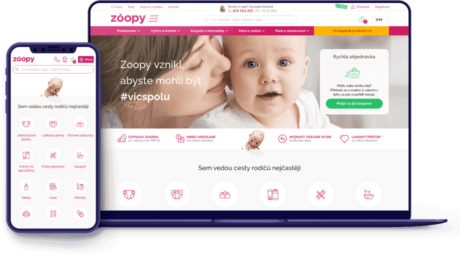In this case study we take a look at how one of Czech’s biggest – yet newest – ecommerce sites for parent was built by using the Shopsys Framework. Despite having long-standing experience building ecommerce sites, the company building the website decided to put together a development team with mostly no prior experience using Shopsys Framework to work on this project. Despite this, they were able to build Zoopy with relative ease thanks to the intuitive code and easy adoption of Shopsys Framework.
Zoopy is a modern B2C e-shop and one of the Czech leading e-commerce sites for parenting with creative aspirations for future growth and expansion. At Zoopy, they believe the best thing parents can do for their children is to be with them – and this is the rationale behind their organization.
The team that was developing Zoopy.cz consisted of 4 back-end developers and 1 front-end developer, headed by a project manager. It was being according to the method of agile development and more than 1000 man-hours throughout 7 months were invested into development of this project.
Back-end developers:
“Automated tests, high coding standards, and intuitive code helped with an easy adoption of SSFW even for unexperienced developers.”
The team responsible for the back-end development consisted of a senior PHP developer (who already had experience with SSFW), one standard PHP developer, and two junior PHP developers (ie. new to the company, basic knowledge of PHP, but no previous experience with SSFW). Despite the majority of the team having had no previous experience operating or using Shopsys Framework, they were able to build Zoopy with relative ease thanks to the intuitive code and easy adoption of Shopsys Framework.

“Since I had already had experience with the Shopsys Framework, I was the one responsible for the development. But I have to praise my co-developers who, even though they had little hands-on experience (either with Shopsys Framework, or with the development of big e-commerce sites), were able to adapt to the Shopsys Framework quickly, allowing us to build a great site! I believe that with the experience gained during this project, they would be able to build an ecommerce project on Shopsys Framework on their own.”
“Specific, yet simple structure, strict coding standards, and an architecture that was easy to use – these are the biggest advantages of Shopsys Framework from my point of view. After I spent a little time on learning and understanding the Symfony framework and MVC architecture, it became quite easy for me to develop on the Shopsys Framework. A very useful feature of Shopsys Framework for me, as a junior developer, were the automated tests, that helped me to stay on the track of whether something was broken or not.”
“What helped us the most, when working on Zoopy’s front-end, was probably the default stable version of the web design. Despite the fact that Shopsys Framework aims to help mainly back-end developers, I found some of its features truly helpful and useful for front-end as well – for example, macros for forms or LESS, that makes maintaining CSS much easier.”
Shopsys Framework is a technology you and your e-commerce site can rely on.
High customizability
The fact that the Shopsys Framework keeps an open door for further improvements and innovation provides you with the freedom of customization, which is necessary if you want to be successful in today’s highly competitive online environment. Shopsys Framework makes it easy to develop any specific functions you would like to have, all without having to remove unnecessary features. The lean platform allows also for a solid SEO optimalization.
Long-term Sustainability
Shopsys Framework is built so it could further grow with your business, while at the same time keeping the site’s complexity low. A new e-commerce site is not something you can build every year. The fact that an e-commerce site runs on Shopsys Framework assures the owner of the site that he or she will not need to build a new e-commerce site for several years.
No Vendor-lock
Last but not least, the fact that the framework is open-source and the e-commerce site owns the code prevents them from the vendor-lock.
Developers Team
They make it happen




